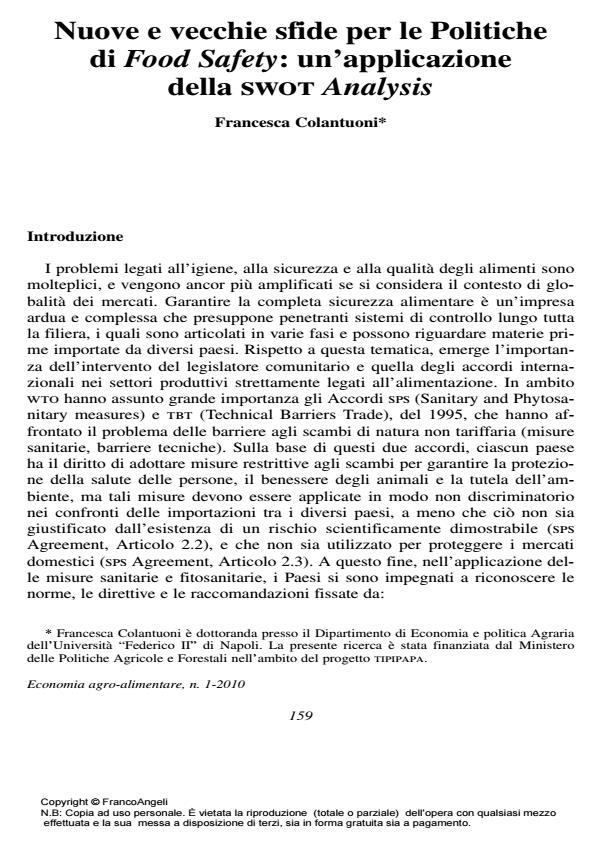Nuove e vecchie sfide per le Politiche di Food Safety: un’applicazione della swot Analysis
Titolo Rivista ECONOMIA AGRO-ALIMENTARE
Autori/Curatori Francesca Colantuoni
Anno di pubblicazione 2010 Fascicolo 2010/1
Lingua Italiano Numero pagine 18 P. 159-176 Dimensione file 1099 KB
DOI 10.3280/ECAG2010-001009
Il DOI è il codice a barre della proprietà intellettuale: per saperne di più
clicca qui
Qui sotto puoi vedere in anteprima la prima pagina di questo articolo.
Se questo articolo ti interessa, lo puoi acquistare (e scaricare in formato pdf) seguendo le facili indicazioni per acquistare il download credit. Acquista Download Credits per scaricare questo Articolo in formato PDF

FrancoAngeli è membro della Publishers International Linking Association, Inc (PILA)associazione indipendente e non profit per facilitare (attraverso i servizi tecnologici implementati da CrossRef.org) l’accesso degli studiosi ai contenuti digitali nelle pubblicazioni professionali e scientifiche
Food safety has become a priority for advanced societies, especially after several food scares, having disrupted the European agro-food system over recent decades. This theme is considered one of the main issues for the agricultural policies of the European Union. In particular, with the Food Safety Law, included in eu Regulation 178/2002, many interventions aiming at enhancing foodstuff quality, in terms of healthiness and food borne risk reduction, have been implemented. Consequently, it is proper to wander whether food safety policies, beside the purpose of guaranteeing safety to consumers, are also suitable to assure sustainable prices for both consumers and enterprises. Another research enquiry concerns weaknesses of European Legislation. More precisely, is it possible to highlight fragilities of policy tools and to propose new solutions for improving their effectiveness? Are there strengths, which allow improving the competitiveness among European agro-food industries? Considering that the effectiveness of food safety tools depends upon interactions with the external environment, the whole economic system, the international commerce, technical advances, consumers, firms; are there recent threats for the European Legislation? By contrast, are there incentives and opportunities? For its immediacy of interpretation and precision of results, in this paper the strategic analysis of eu Regulation 178/2002 is carried out by means of the swot. The swot method (Strengths, Weaknesses, Opportunities, Threats) regards the analysis of an organisation’s internal and external environment, and its application allows a deep and accurate analysis of European Legislation on food safety, with the aim of identifying strengths, which will allow taking advantage from external opportunities and avoiding or contrasting threats. At the same time, weaknesses will be highlighted, with the purpose to make a balance and to understand where the Legislation fails, and where it is necessary to intervene. Attained results, in fact, permit the assessment of effective efficiency of food safety tools, in order to face new and old challenges for the agro-food system, and also the capability, or potentiality, in achieving consumer’s welfare, with the social equity objective. These results can be useful for policy makers, taking into account the most recent evolution of the economic system and society. Some of results can be also used by agro-food firms needing to better understand dynamics of legislative, economic and social environment, with the aim of improving their productive and commercial strategies.
Parole chiave:Eu Reg. 178/2002, food safety, agro-food industries, swot
Jel codes:Q18, I18, L51, H23, K20
Francesca Colantuoni, Nuove e vecchie sfide per le Politiche di Food Safety: un’applicazione della swot Analysis in "ECONOMIA AGRO-ALIMENTARE" 1/2010, pp 159-176, DOI: 10.3280/ECAG2010-001009